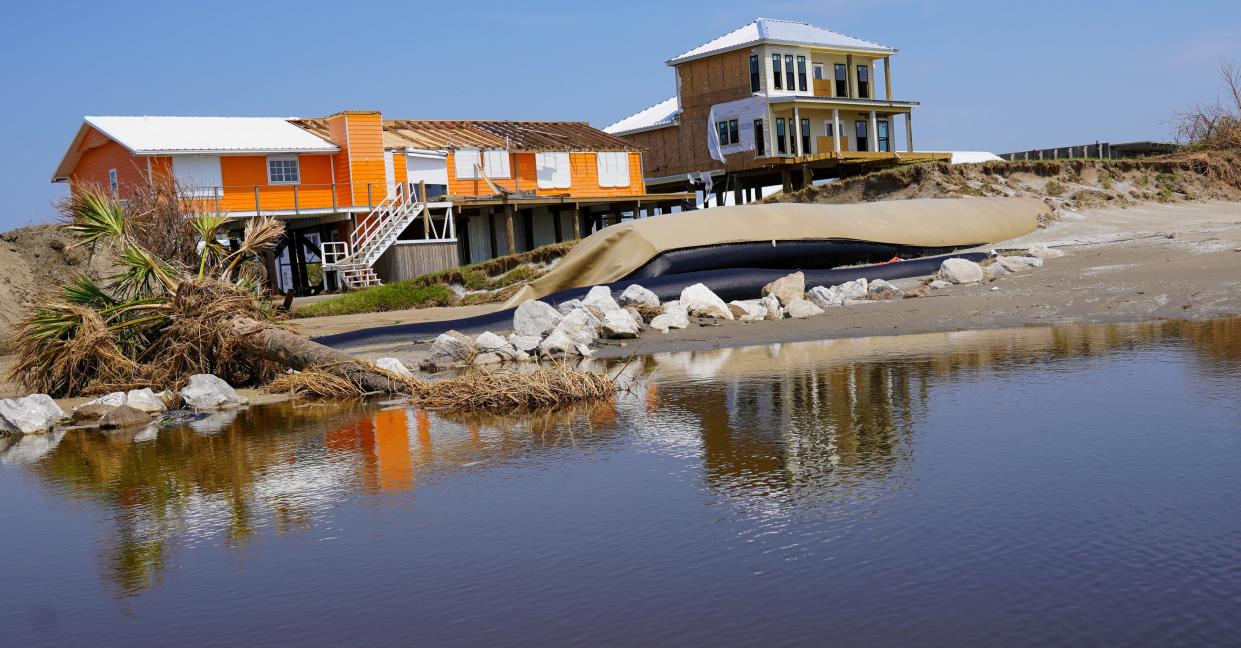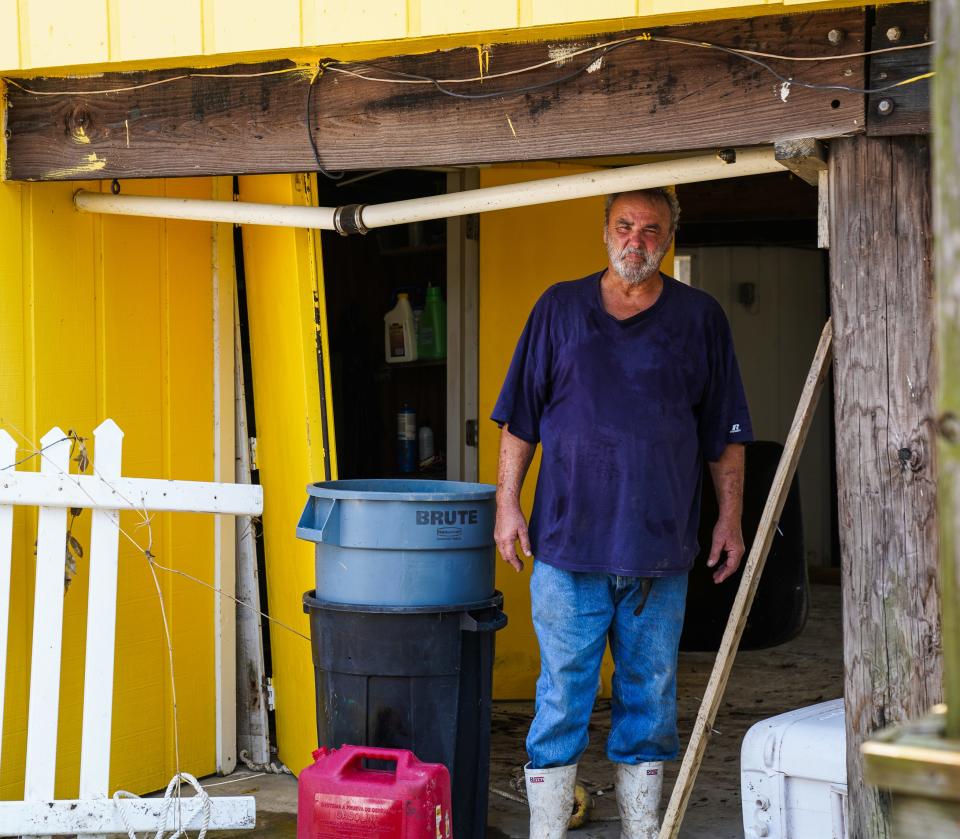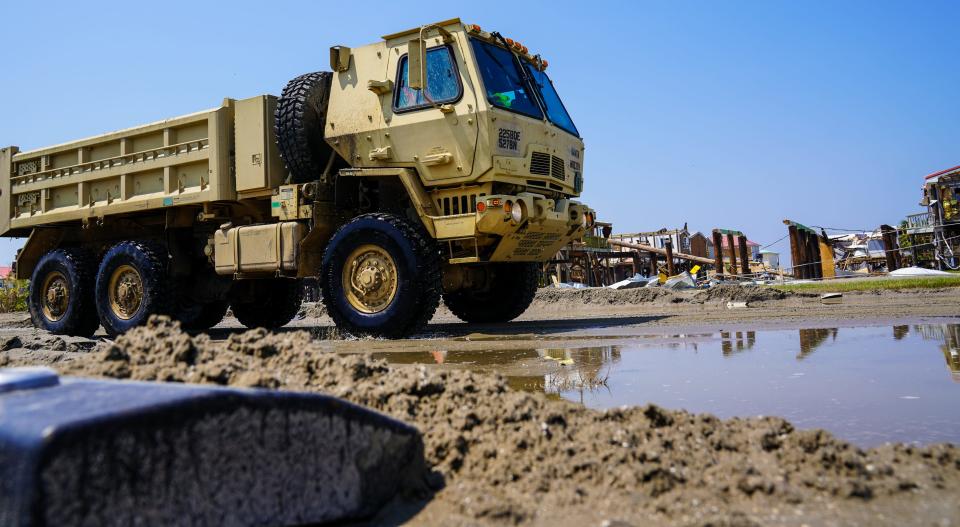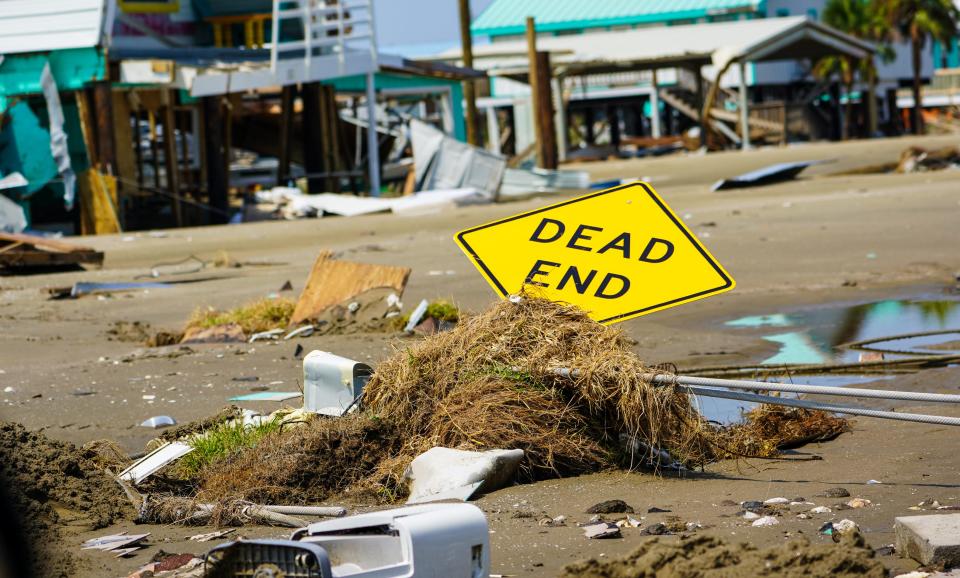Rising seas, sinking land: Life on this Hurricane Ida-battered Louisiana barrier island may never be the same

GRAND ISLE, Louisiana — Jules Melancon steps over roofing shingles littering his yard, around a downed tree and ducks beneath a twisted aluminum beam of the shed in his backyard.
“I was lucky, I tell you," the third-generation oyster farmer says. "My house came through OK."
Looking around, Melancon points out the destruction caused to this tortilla-flat barrier island when Hurricane Ida roared ashore 10 days prior, ripping holes in the island's defensive levees, pouring saltwater onto low-lying areas and inundating others with several feet of sand while ripping apart homes and businesses.
Virtually every building suffered some damage, and as many as 40% of the houses and summer homes known as "camps" were destroyed, according to authorities. The island was declared effectively uninhabitable, water service was severed, and power is not expected back until month's end.
Climate Point: Subscribe to USA TODAY's weekly newsletter on climate, energy and the environment
With insurance and FEMA assistance, Melancon, 63, is already making plans to repair his oyster-sorting shed, to clean his yard of debris, and to replace the lawnmower swamped by Hurricane Ida's storm surge.
But while Melancon suffered relatively little damage this time, things could have been much worse, not just for him but for all of the approximately 1,500 people who call this island home, and for the tens of thousands more who vacation here each summer. Experts say Grand Isle is a harbinger for things to come: rising sea levels, stronger storms and more destruction for coastal areas.

With sea levels rising an average of 3.6 millimeters annually due to climate change, Louisiana's coast is simultaneously sinking, possibly in connection with the vast amounts of oil, natural gas and water that have been extracted over the past decades to fuel and power the United States.
That means places like Grand Isle, reached by a long causeway from mainland Louisiana, is demonstrating today what other coastal areas will see in the coming years.
And it raises questions about how long governments will try to protect property and how much tax money they're willing to spend rebuild roads and power lines and homes before ceding it to the sea. In 2014, federal scientists said Grand Isle sank 1.3 inches in five years, one of the largest drops globally.
"The Louisiana coast is in general a canary in the coal mine," said Samuel Bentley, a Louisiana State University expert on coastal erosion. "We are experiencing conditions now that other areas will face in the future. From the perspective of a homeowners or a city official, it doesn't matter if it's subsidence or sea level rise. It becomes a political decision at some point."
The history of 'hauntingly beautiful' Grand Isle, Louisiana
Federal, state and local officials have long known the danger faced by Grand Isle, which under normal circumstances is a bucolic, sandy island with shave ice shops, fishing rodeos and beach bar after beach bar.
Last year, the New York Times declared the island one of its top places to visit for 2020, ranking it with Greenland, Tokyo and the British Virgin Islands. But the reporter also asked, "Does a place appear more hauntingly beautiful when you know it’s disappearing?"
First used by indigenous, nomadic natives, the Grand Isle and nearby Chenière Caminada and Leeville areas grew in the early 1800s as the French, Spanish and growing United States colonized Louisiana. Pirate and privateer Jean Lafitte frequented the area, and Confederate soldiers during the Civil War occupied an unfinished fort on adjacent Grand Terre Island, fleeing after the United States retook New Orleans.

After the enslavement of people was banned following the Civil War, plantations on Grand Isle were replaced by vacation resorts for the wealthy. They were themselves destroyed and then rebuilt following the 1893 Chenière Caminada hurricane, which sent a wall of water 16 feet high across the area, killing about half of the residents of the nearby farming community and erasing the fields that once grew produce for New Orleans.
The U.S. Army Corps of Engineers has been trying to repair and protect the island since 1976, and in some areas installed a giant sand-filled tube known as "the burrito" running parallel to the ocean's waves at the highest point on the beach.
'It ain't easy right now': Hurricane Ida strands residents, wipes away landmarks on Louisiana island
Those efforts have been repeatedly set back by hurricanes: 2005's Katrina damaged the repairs, which were almost fixed by the time Gustav arrived in 2008, destroying some of the repairs to the repairs. Subsequent hurricanes damaged subsequent repairs, and last summer, state taxpayers spent $7.5 million repairing levee breaches and building a new 1¼-mile-long beach, which immediately became a popular gathering spot, drawing more people to the island.
“It was a great summer, the island was booming. You could feel everyone doing good," said seventh-generation Grand Isle resident Holden Landry, 25.
Landry's family has owned one of the island's grocery stores, Sureway Supermarket since his grandfather founded it in 1976. His grandfather, Landry said, never saw storms like Ida.

"My mom had two of these storms. And my sister and I had our first one at 25 and 27," Landry said. "We all have a business plan down here, but God kinda scribbled over our plans.”
Ida knocked out power to the Landry's store, spoiling all the refrigerated and frozen food. As the island struggled without electricity 10 days later, Landry sat outside the store in a golf cart, escorting in what few customers came so they could buy essentials, from coffee to gas cans needed to keep generators running.
Landry, who left the island to attend college on the mainland, returned after graduation to help run the store, and now has a two-month-old son, the eighth generation to be raised here.
“Each storm that hits, people go away. There’s elderly locals who just don’t come back," he said. “The easiest thing you could do is move away. But I want to stick it out. There’s a lot of pride in being down here. If you have to start over, might as well start over in a place you have pride.”
Climate could make hurricanes like 'freakish' Ida more common
A few doors down, Chris Collins took stock of his family's gas station and convenience store, Jo-Bob’s. Like Sureway, the store wasn't officially open, but Collins and his mom were around to sell gas for generators, taking cash from people who had it, and giving IOUs to the others.
“I’m grateful and humbled in ways I’ve never been before," said Collins, who rode out the storm. "That was a freakish storm. The worst case scenario? We just saw it.”
Experts predict storms like Ida will become more common as ocean waters warm, providing more heat energy to spin up hurricanes. Ida wasn't actually a worst-case scenario, they point out, because it intensified so rapidly that it never had time to generate a truly large surge like the 16-foot-high one from the 1893 Chenière Caminada hurricane.

Nevertheless, the howling winds ripped apart buildings, snapped power poles and drove stormwater nearly across the island. The three-foot-surge that hit the causeway serving Grand Isle peeled up portions of the road like flaking paint, narrowing the road to one lane in many areas.
Collins, 44, lived in New York City for many years, returning recently to help his parents run the store. He said he was shocked on his return to see how many more camps had been built in areas longtime locals would never have chosen, and the erosion of protective marshland caused by ships serving the offshore oil platforms blinking in the Gulf of Mexico.
He said he believes the loss of the island is ultimately inevitable – but struggles with how to adapt. Do they try selling to someone else? Wait for a government buyout? Just keep rebuilding their canopy and roof?
“Running is not an option for me now," he said after a pause. "The island still has its magic."
Back at his home, Melancon is picking through the debris, watching for roofing nails scattered in the grass, and wondering when the electricity and water will come back on. The seas have finally calmed, and he's anxious to get out to his oyster beds.
His grandfather used to harvest oysters around Independence Island, but that has vanished beneath the waves, and Melancon now farms his oysters in several bays around Grand Isle.
“God took care of me," he said. “I just want to get back to work.”
The uncertain future of Grand Isle: 'Barrier islands are not forever'
The conversations people on Grand Isle need to have are the same kinds of conversations coastal residents around the world need to be having, said Mark Davis, 67, the professor who directs the Tulane Center for Environmental Law.
"Communities have to have a real conversation about the choices. Because otherwise at some point, decisions will be made for it," Davis said. "The kind of issues that Grand Isle presents will replay in Miami Beach, in Norfolk, Virginia. We are going to face these questions and our options for each are different. But not one of them is ensured a future."
WATCH: Louisiana slowly reopening after Hurricane Ida
Recovering from disaster: Hurricane Ida will be 'devastating' to tourism industry
Davis said the physics of what's happening to Grand Isle are not up for debate, regardless of climate change – sandy barrier islands wash away while bearing the brunt of whatever storms hit them. Climate change, he said, is accelerating a geological process that's been well underway for centuries.
"Barrier islands are not forever. And sea levels are not forever. And right now they are shifting and changes at rates we have no experience with," he said. "Grand Isle is in transition. The question is, transition to what? At some point, you hit a point of no return. I personally hope they can make it last as long as possible. But the fate of this coast will determine the fate of Grand Isle."
This article originally appeared on USA TODAY: Louisiana island, beat up by Hurricane Ida, nears 'point of no return'

